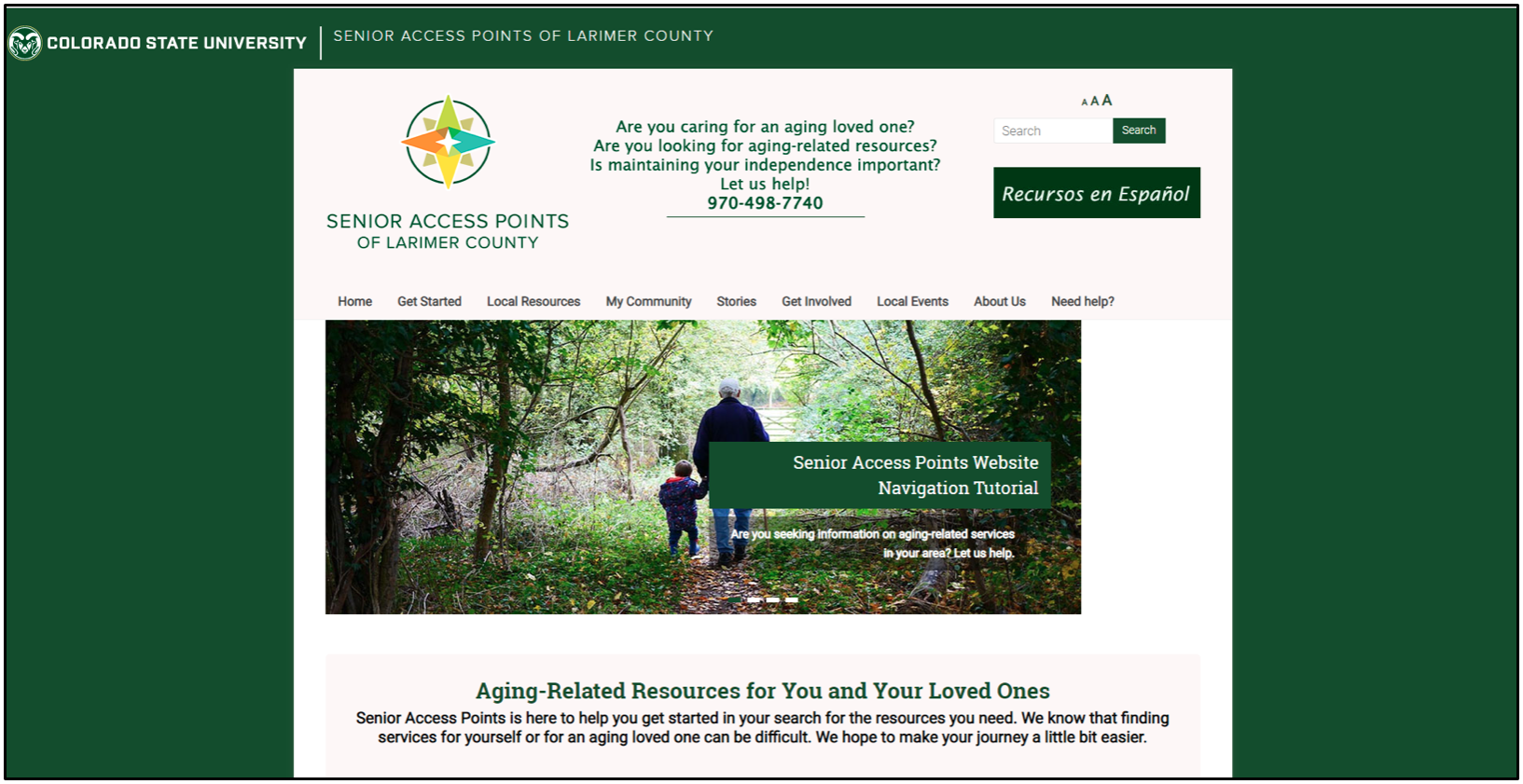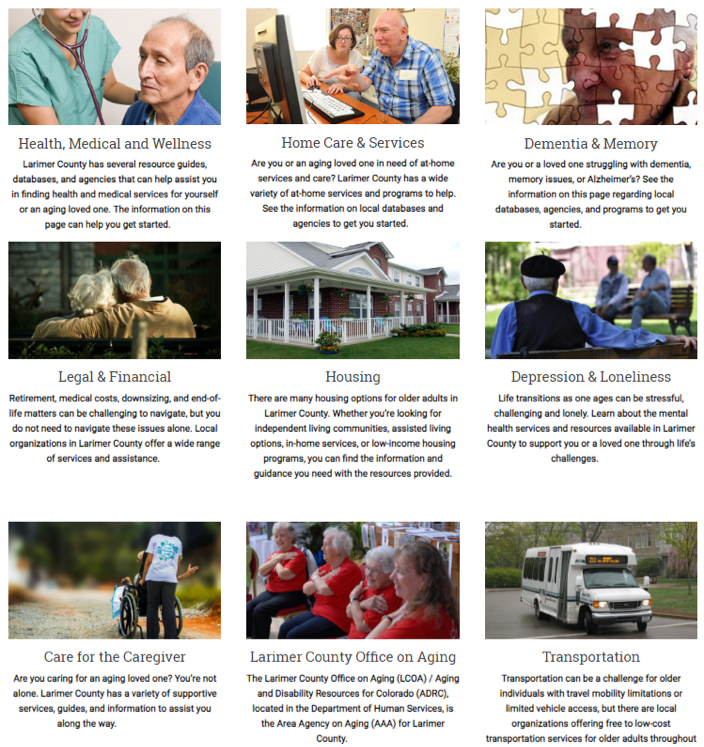 |
December 2019
|
December 2019 // Volume 57 // Number 6 // Ideas at Work // v57-6iw4
Senior Access Points: Increasing Awareness of Aging-Related Resources
Abstract
As the United States' population ages, connecting older adults to supportive resources is more important than ever. Colorado State University Extension has played a central role in implementing Senior Access Points, a program that delivers community outreach and education regarding aging-related resources available to older adults and caregivers. This article outlines four key components of development of the program: building a website, producing outreach materials, training volunteer ambassadors, and establishing a county-wide, coordinated outreach effort designed to break down resource access barriers. With outreach strategies tested and established in one county, the program is now being replicated by Extension professionals across Colorado.
Introduction
As the population in the United States ages, community efforts are needed to connect older adults with resources and services that support healthy aging. Larimer County, Colorado, has seen a downward trend in community awareness of aging-related resources, a shift that mirrors national trends (National Research Center, 2018). Lack of awareness is a major factor that leads to underuse of resources (Li, 2006; Wacker & Roberto, 2019). Families often do not know where to look for resources (Denton et al., 2008), and this issue is further compounded by the fact that they typically do not seek out resources until a crisis occurs (Magilvy & Congdon, 2001). Raising community residents' awareness of aging-related resources can have meaningful positive effects for aging individuals and their families.
To increase resource awareness in our community, we formed Senior Access Points, a university–community partnership led by Colorado State University (CSU) Extension. The program has four key components: a user-friendly website (www.LarimerSeniors.org), professionally designed outreach materials, a volunteer ambassador program, and a coordinated, county-wide outreach campaign. Senior Access Points has demonstrated positive results in breaking down resource access barriers, and with leadership from Extension professionals, it can be adapted for other communities.
Project Development
The Senior Access Points project emerged when a team of agency collaborators and community volunteers coalesced to explore an identified community need in the context of a grassroots organization called the Partnership for Age-Friendly Communities. The goal of the team, which we led, was to better understand barriers to community awareness about local aging-related programs and services.
Our team implemented a community assessment process in 2017 (for details on the assessment approach and results, see Schneider & Brothers, 2019). Results indicated that despite the many aging-related resources available, most individuals did not know where to begin their search. The top places respondents looked (medical offices and the Internet) often did not lead them to the "right door." As a result individuals often needed to explain their stories multiple times, leading to frustration as well as curtailment of their searches. We also learned that services provided by the local office on aging were being underused.
On the basis of assessment findings, we first formalized the Senior Access Points leadership team to include representatives from
- the Larimer County office of CSU Extension (project lead),
- CSU's Department of Human Development and Family Studies,
- Partnership for Age-Friendly Communities, and
- Larimer County Office on Aging.
Next, we planned and implemented the four key components of the Senior Access Points project.
- We developed an unbiased, user-friendly, easy-to-navigate website populated with information on aging-related resources in nine topic areas (www.LarimerSeniors.org) (see Figure 1). The website is continually updated on the basis of feedback from community members and professionals.
- We created outreach materials (rack cards, business cards, magnets) with a simple message to lead people to the "right door" (see Figure 2).
- We initiated a volunteer ambassador training program to educate frontline staff at community and medical centers about aging-related resources (see the Senior Access Points ambassador video at https://youtu.be/nUM7s6z-4eo).
- We organized a coordinated, county-wide outreach campaign involving a coalition of professionals from over 30 organizations. We share quarterly updates and keep our partners stocked with outreach materials.
Figure 1.
Senior Access Points Website Homepage and Nine Topic Areas


Figure 2.
Example of Senior Access Points Outreach Materials (Rack Card)

Outcomes
During the first year of our program (2018), our team presented information on aging-related resources to 525 attendees in 22 meetings. With the help of nine trained volunteer ambassadors, we visited 117 community sites and distributed 6,125 outreach material items. Additionally, we averaged 192 new website users per month.
Given the positive outcomes in Year 1, we were awarded a 2-year (2019–2020) grant from the NextFifty Initiative, a nonprofit foundation based in Denver, Colorado. The purpose of the grant was to allow us to expand our outreach into rural areas of our county. We built a rural coalition that taps into existing infrastructure, including volunteer fire departments and rural transportation providers. Community members and professionals serve as Senior Access Points ambassadors in the rural communities in which they reside.
We saw strong outcomes in the first two quarters of Year 2 (2019). Between January and June, we presented at 42 meetings to 911 participants. We trained seven volunteer ambassadors and distributed 7,292 outreach material items. The average number of new website users increased from 192 per month in 2018 to 286 per month in the first quarter of 2019.
Next Steps and Statewide Expansion
Our current focus is to train volunteer ambassadors throughout the county (in both rural and urban areas) who can then sustain education and outreach efforts in neighborhoods and communities. Extension continues to manage the website, produce outreach materials, direct outreach efforts, and train and support volunteers, while the CSU Department of Human Development and Family Studies leads the evaluation effort.
We have shared our program model with Extension agents throughout Colorado. Four key features provide the basis for replication and adaptation of Senior Access Points:
- The community assessment survey can be adapted to any local geography.
- The website template is housed within CSU Extension and can be made available to other Extension offices for adaptation.
- The logo can be adapted (i.e., "Senior Access Points of {insert county/region here}"), and the outreach material templates can be populated with local contact information, including for a locale's area agency on aging.
- The volunteer training protocol and process manual are available for adaptation.
We are in the process of replicating Senior Access Points in northeastern Colorado in partnership with three county Extension offices, the CSU Northeast Regional Engagement Center, and the Logan County Heritage Center. The replication process includes conducting a local community assessment to understand needs and barriers specific to the region.
Conclusion
As the population ages, Extension professionals can play a central role in supporting safe and healthy aging (e.g., Peek & Bishop, 2016). Senior Access Points can serve as a replicable model through which community coalitions can build partnerships, conduct assessments, develop resource tools, and train volunteers to increase community awareness about local resources. It is our hope that this model can help connect older adults and caregivers to critical aging-related resources before crisis situations arise and thus help close the information access gap for families in Colorado and beyond.
Acknowledgments
We gratefully acknowledge the Senior Access Points leadership team members: Jim Becker (Partnership for Age-Friendly Communities) and Lynda Meyer and Linda Rumney (both with the Larimer County Office on Aging), who have been amazing contributors and collaborators throughout our project's evolution. Appreciation also goes to our many community partners, volunteers, and students who have given life and shape to our collective work. Funding for the project has been provided by CSU's Department of Human Development and Family Studies and the NextFifty Initiative.
References
Denton, M., Ploeg, J., Tindale, J., Hutchison, B., Brazil, K., Akhtar-Danesh, N., . . . Boos, L. (2008). Where would you turn for help? Older adults' awareness of community support services. Canadian Journal on Aging, 27, 359–370. doi:10.3138/cja.27.4.359
Li, H. (2006). Rural older adults' access barriers to in-home and community-based services. Social Work Research, 30, 109–118, https://doi.org/10.1093/swr/30.2.109
Magilvy, J. K., & Congdon, J. G. (2001). The crisis nature of health care transitions for rural older adults. Public Health Nursing, 17(5), 336–345. https://doi.org/10.1046/j.1525-1446.2000.00336.x
National Research Center. (2018). Community Assessment Survey for Older Adults (CASOA) report of results. Retrieved from https://www.larimer.org/sites/default/files/uploads/2018/larimer_county_casoa_report_2018_final.pdf
Peek, G. G., & Bishop, A. J. (2016). Keeping it safe: Aging in place among rural older adults. Journal of Extension, 54(2), Article 2RIB5. Available at: https://joe.org/joe/2016april/rb5.php
Schneider, S., & Brothers, A. (2019). "I wish I had known"—Understanding barriers to accessing aging-related resources. Journal of Extension, 57(6), Article 6RIB2. Available at: https://joe.org/joe/2019december/rb2.php
Wacker, R. R., & Roberto, K. A. (2019). Community resources for older adults: Programs and services in an era of change. Washington, DC: Sage.




